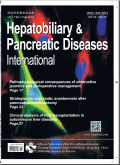- 钛学术文献服务平台 \
- 学术期刊 \
- 医药卫生期刊 \
- 内科学期刊 \
- 国际肝胆胰疾病杂志(英文版)期刊 \
Predictors of recurrent bile duct stone after clearance by endoscopic retrograde cholangiopancreatography: A case-control study
Predictors of recurrent bile duct stone after clearance by endoscopic retrograde cholangiopancreatography: A case-control study
基本信息来源于合作网站,原文需代理用户跳转至来源网站获取
摘要:
Background: Recurrent common bile duct (CBD) stone is a long-term sequalae among patients who un- derwent endoscopic retrograde cholangiopancreatography (ERCP) with CBD stone extraction. Data regard- ing risk factors for recurrent CBD stone are scarce. We aimed to identify predictors of recurrent CBD stone.Methods: We performed a retrospective case-controlled study from January 2010 to December 2019. In- clusion criteria included patients who had recurrent CBD stone at least 6 months after the index ERCP, in which complete stone extraction was performed and normal cholangiogram was obtained. Overall, 457 patients were included. Forty-two patients (9.2%) had recurrent CBD stone, and 415 patients (90.8%) did not have recurrent CBD stone . Results: In univariate analysis, male sex [odds ratio (OR) = 0.49, P = 0.033] was a protective factor, while endoscopic stone extraction by basket vs. balloon (OR = 2.55, P = 0.005), older age (OR = 1.03, P = 0.003), number of CBD stones (OR = 1.99, P = 0.037), size of CBD stone (OR = 4.06, P = 0.003) and mechanical lithotripsy (OR = 9.22, P = 0.004) were risk factors for recurrent CBD stone. In multivariate logistic regression analysis, mechanical lithotripsy [OR = 9.73, 95% confidence interval (CI): 1.69–55.89, P = 0.010], basket clearance vs. combined basket and balloon (OR = 18.25, 95% CI: 1.05–318.35, P = 0.046) and older age (OR = 1.02, 95% CI: 1.00–1.05, P = 0.023) were risk factors, and male sex (OR = 0.39, 95% CI: 0.19–0.81, P = 0.012) was a protective factor. Conclusions: We identified modifiable and non-modifiable risk factors for recurrent CBD stone. Taking into consideration those factors might aid in minimizing the CBD stone recurrence risk.

推荐文章
Elemental characteristics and paleoenvironment reconstruction: a case study of the Triassic lacustri
Trace elements
Occurrence mode
Paleoenvironment
Zhangjiatan oil shale
Yanchang Formation
Ordos Basin
Iron isotope fractionation during fenitization: a case study of carbonatite dykes from Bayan Obo, In
Iron isotopes
Fenitization
Fluid exsolution
Carbonatite
Bayan Obo
Effects of carbon anhydrase on utilization of bicarbonate in microalgae: a case study in Lake Hongfe
Microalgae
Carbonic anhydrase
Stable carbon isotope
Inorganic carbon utilization
Optimizing the ratio of the spike to sample for isotope dilution analysis: a case study with seleniu
Isotope dilution method
Error propagation
Mento Carlo
Se concentration
Geological reference materials
内容分析
关键词云
关键词热度
相关文献总数
(/次)
(/年)
文献信息
| 篇名 | Predictors of recurrent bile duct stone after clearance by endoscopic retrograde cholangiopancreatography: A case-control study | ||
| 来源期刊 | 国际肝胆胰疾病杂志(英文版) | 学科 | |
| 关键词 | |||
| 年,卷(期) | 2022,(1) | 所属期刊栏目 | BILIARY |
| 研究方向 | 页码范围 | 50-55 | |
| 页数 | 6页 | 分类号 | |
| 字数 | 语种 | 英文 | |
| DOI | |||
五维指标
引文网络
引文网络
二级参考文献 (0)
共引文献 (0)
参考文献 (0)
节点文献
引证文献 (0)
同被引文献 (0)
二级引证文献 (0)
2022(0)
- 参考文献(0)
- 二级参考文献(0)
- 引证文献(0)
- 二级引证文献(0)
引文网络交叉学科
相关学者/机构
期刊影响力
国际肝胆胰疾病杂志(英文版)
主办单位:
浙江大学医学院第一附属医院
出版周期:
双月刊
ISSN:
1499-3872
CN:
33-1391/R
开本:
大16开
出版地:
浙江省杭州市庆春路79号
邮发代号:
创刊时间:
2002
语种:
eng
出版文献量(篇)
1879
总下载数(次)
0
期刊文献
相关文献
推荐文献
- 期刊分类
- 期刊(年)
- 期刊(期)
- 期刊推荐
国际肝胆胰疾病杂志(英文版)2022
国际肝胆胰疾病杂志(英文版)2021
国际肝胆胰疾病杂志(英文版)2020
国际肝胆胰疾病杂志(英文版)2019
国际肝胆胰疾病杂志(英文版)2018
国际肝胆胰疾病杂志(英文版)2017
国际肝胆胰疾病杂志(英文版)2016
国际肝胆胰疾病杂志(英文版)2015
国际肝胆胰疾病杂志(英文版)2014
国际肝胆胰疾病杂志(英文版)2013
国际肝胆胰疾病杂志(英文版)2012
国际肝胆胰疾病杂志(英文版)2011
国际肝胆胰疾病杂志(英文版)2010
国际肝胆胰疾病杂志(英文版)2009
国际肝胆胰疾病杂志(英文版)2008
国际肝胆胰疾病杂志(英文版)2007
国际肝胆胰疾病杂志(英文版)2006

 免费查重
免费查重










